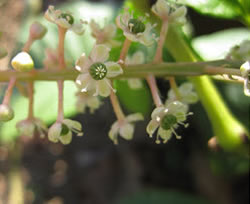Plant of the Week
 Phytolacca americana range map. USDA PLANTS Database.
Phytolacca americana range map. USDA PLANTS Database.
 American Pokeweed (Phytolacca americana) ripe fruit on raceme. Image with permission by David D. Taylor.
American Pokeweed (Phytolacca americana) ripe fruit on raceme. Image with permission by David D. Taylor.
 American pokeweed (Phytolacca americana) close up of flower. Image permission by David D. Taylor.
American pokeweed (Phytolacca americana) close up of flower. Image permission by David D. Taylor.
 American pokeweed (Phytolacca americana) plant at edge of wood lot. Image permission by David D. Taylor.
American pokeweed (Phytolacca americana) plant at edge of wood lot. Image permission by David D. Taylor.
American Pokeweed (Phytolacca americana L.)
By David Taylor
American pokeweed is a member of the Phytolaccaceae, the Pokeweed family. Members of the family are found around the world in tropical and subtropical distribution with a few species that occur in temperate areas. About 16 genera and 100 species are recognized in the family. The genus Phytolacca contains about 25 species which range from herbs to shrubs to tall trees. Two native species of pokeweed are recognized in North America, one found across much of North America and one found in California and the southwestern U.S. A few tropical species have been introduced unintentionally in imported products or intentionally as ornamentals.
This pokeweed is usually 1.8 meter to 3.0 meters (about 6 to 10 feet) tall, but may in some instances reach 21 feet tall. One or more stems arise from a tuber-like taproot that can become large over several years. The often pinkish-red, smooth and partially hollow stem is rigid to flexible, not strong, and up to 5 centimeters (2 inches) diameter.
The leaves are alternate, thin, green on top, and lighter below. The leaves are usually 20 to 35 centimeters (7 3/4 to 14 3/4 inches) long by 10 to 18 centimeters (about 4 to 7 inches) wide. They are tapered at both ends. Bruised or crushed leaves and stems have a somewhat acrid odor.
Flowers are borne in pinkish racemes, linear clusters with each flower on a short stem. The flowers are usually white to greenish, but may be pinkish or purplish. Flowers have 5 sepals, no petals, about 10 stamens. It produces purple-black berries that are about 6 to 11 millimeters (1/4 to 2/5 inches) diameter with 6 to 12 seeds.
American pokeweed is a species of open or edge habitats, especially those where birds are able to roost. It is found at forest edge, in fence rows, under power lines, pastures, old field, forest openings, and other similar areas. It is sometimes a garden or yard weed. It is found from Washington south to California then east through Arizona and New Mexico to the Atlantic coast, north to Nebraska, Minnesota and Maine. It is also found in Ontario, Quebec, and New Brunswick in Canada.
This species may flower year around in southern states, and May to October in northern states. The entire plant is poisonous causing a variety of symptoms, including death in rare cases. The berries are especially poisonous. Young leaves and stems when properly cooked are edible and provide a good source of protein, fat and carbohydrate. Regional names for the plant include poke, poke sallet, poke salad, and pokeberry. The fruits are important food for mockingbirds, northern cardinals, and mourning doves. The name “phytolacca” means red dye plant.

